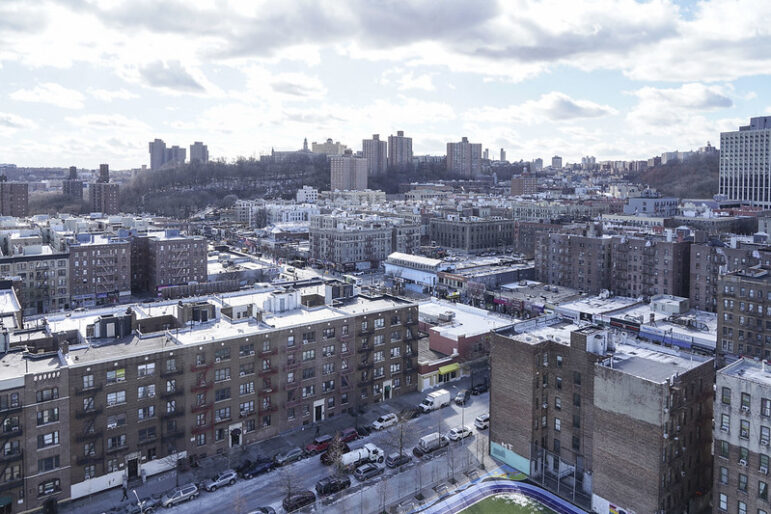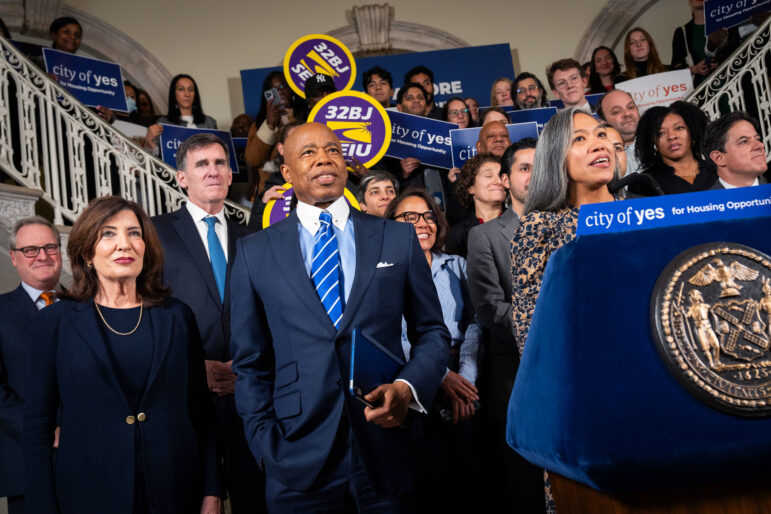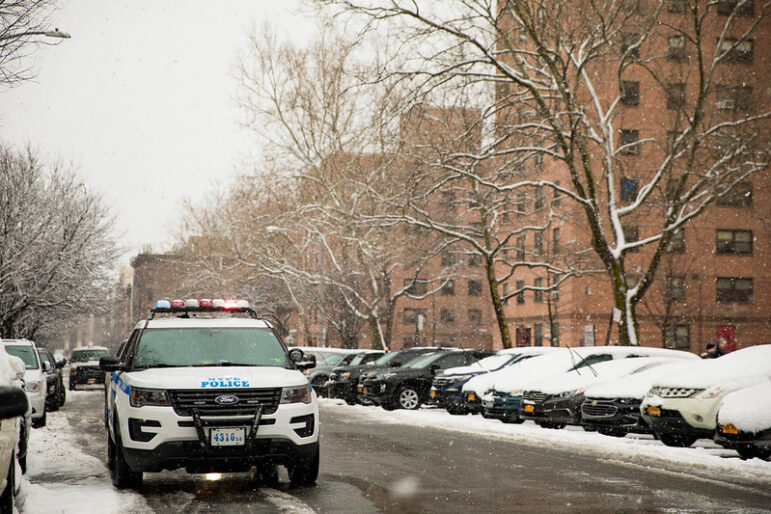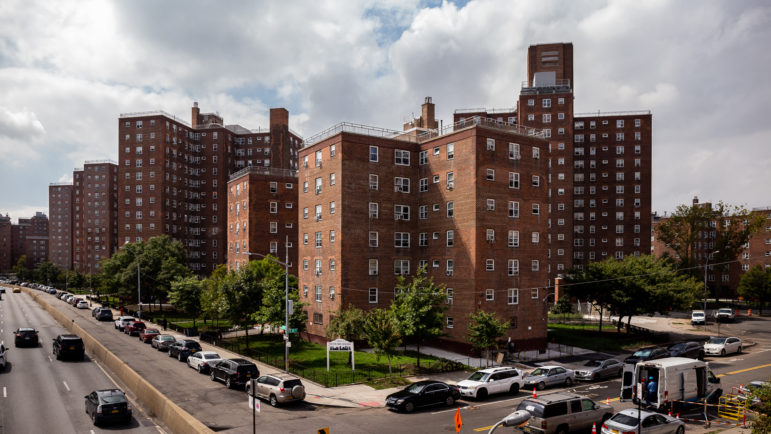Over the last 20 years, the two big apartment buildings at 640 and 644 Riverside Drive have been a laboratory for real estate disaster. The tenants have wanted for heat, hot water, elevators, garbage pickup, door locks, functional windows and electricity–tallying about 2,000 building violations by the late 1980s. They’ve been through seven court cases, and seen about five or six judges. And the buildings–owned by two of the city’s most notorious landlords–have been neglected, warehoused and abandoned. They’ve bested the efforts of four different court-appointed administrators, and, in the early 1990s, nearly destroyed a community housing organization that tried to manage them. In the past decade, the city pumped $1.7 million in loans into the buildings to restore utilities; the debt on the two properties now tops $7 million.
These two buildings, spanning the block between 141st and 142nd streets, have endured every nightmare that can plague a good building in a bad neighborhood. It’s as if the entire history of the downfall and resurrection of New York City’s low-cost real estate is played out at these addresses, starting with lousy landlords and toothless housing policy, winding through endless tenant struggles and court campaigns, and ending up on the doorstep of gentrification.
This could also be the moment of redemption for 640 and 644 Riverside Drive, as the buildings may finally be delivered into the hands of the tenants.
As this saga unfolded, the residents became experts in plucking these besieged buildings from the brink of total failure. Out of necessity, they became negotiators, managers, legal advocates, historians. Soft-spoken tenant association president Salvador Orochena mastered English, trained to be a mediator, building manager and notary, and even wound up going to law school, inspired by the battles in the building.
More than anything, these tenants were able to keep the buildings going through sheer will and a remarkably resourceful kind of collective guile.
For instance, in the early 1980s, they set up a daily flashlight patrol, in which residents stood on the landings until about 9 p.m. in order to keep the darkened halls safe. Another time, the building’s heat was out and an elderly woman on one of the top floors started having problems breathing because of the freezing cold. An ambulance came, but the elevator wasn’t working either. “The [EMT] guys were ready to walk out,” Orochena recalls. “We said, ‘She’s gonna die!'” Instead, a group of tenants ended up putting the woman in a chair and trundling her downstairs.
The buildings on Riverside Drive aren’t just a lesson in real estate. They are also a textbook example of what tenants can do when they band together, and what happens when tenant alliances fall apart.
These two buildings broke down into about 10 distinct tenant associations over the years. There was a time when 640 Riverside Drive had three different tenant groups at once. At another point, the exhausted leaders of the tenant group at 644 Riverside Drive came to blows with other residents who had accused them of mismanaging funds. Ultimately, these bitter conflicts lost them one big opportunity to own the buildings outright.
This year, they may get their last chance. The two buildings have now been assigned to the city’s new property transfer program for delinquent landlords, and in the coming months, the City of New York will make a final judgment. It will pass 640 and 644 Riverside Drive off to a private landlord–probably the buildings’ current administrator–or hand it to the tenants themselves.
Many of the residents have rallied to the cause, but it doesn’t look good for them; the housing department plans to hand most of the buildings in this program over to professional managers.
By all rights, this quintessential New York housing story should end with a happy transformation, where the tenants become their own landlords and live a blissful co-op life in the buildings that once tormented them. Instead, after 20 years, this epic will end with a bureaucratic decision that may put these buildings into the hands of a landlord many of the tenants don’t like or trust. It certainly isn’t the end the tenants would have anticipated 20 years ago, when their buildings first began to fall apart.
_______
The 200 apartments at 640 and 644 Riverside Drive were built in 1914 to house the well-heeled intelligentsia of upper Manhattan. An elderly Jewish couple that moved there in 1944–soon after they escaped Nazi Germany–recalls that back then, 141st Street and Riverside Drive was quite an elegant address. By 1963, when Calvin Samuels moved in, “there were still vestiges of what had once been a very fine building,” he remembers, with ornate furniture in the lobby and a doorman uniformed in maroon and gold.
But by the late 1970s, the buildings had been sucked into the same ordeals that were ravaging much of Harlem and Washington Heights, including slumlords, drug trade and decay. The buildings got caught in a game of hot potato between two of the city’s most infamous landlords: Andonis Morfesis, who later served jail time for conditions in his other buildings, and the DiLorenzo family, whose patriarch had set up a real estate empire worth about $1 billion before his death in 1975, when the family and its holdings fellinto turmoil. The residents say Morfesis and Alex DiLorenzo III swapped the building back and forth, allowing them to get more cash in mortgages and stay one step ahead of city tax collectors and building inspectors. It was a lucrative game that landlords were playing citywide, milking old buildings for all they were worth.
Meanwhile, weeks passed without heat or hot water. People moved out. Broadway, just a block away, was taken over by drug traffic, and soon the majestic Riverside buildings, once a bulwark against crime, admitted dealers as paying tenants.
Then, in the winter of 1979-1980, the boiler in 640 almost melted down. “The mechanism that would turn it off failed, and the boiler was burning red,” remembers Samuels, then president of the tenant association at 640. Trembling, he shut it down manually. “I had to post a notice that we were like a ship in the ocean without an engine.” Residents were left with no heat, rattling windows and memories of tinsel blowing around on their Christmas trees.
The tenants began collaborating during that harsh, chaotic winter, at first simply to keep warm and safe. Because so many people were plugging in electric heaters, the fuses were constantly blowing. So they set up a system: For groups of apartments that shared a fuse, residents took turns plugging in their heaters.
Fairly quickly, they got drawn into a collective crusade. By late 1981, with the buildings on seasonal rent strike, the tenant association in 640 Riverside Drive had opened a bank account to pay for some maintenance work. The tenants set up an office, staffing it five days a week with volunteers ready to collect rent and issue receipts. A small group of residents even trained to become court-appointed building managers, and several actually served in that capacity.
In response, the landlords tried to cut back further on upkeep costs, says Orochena. The court-appointed receiver, Edward Howard, hired a slew of managers that the tenants say did nothing. Six managers came and went in five years.
But by then, the tenants had already seen their way out of this mess. They were planning to take over the building.
_______
Even in those crisis years, keeping a consensus going wasn’t easy–particularly in the spring. When the freezing cold made unity a matter of life and death, the tenants were able to stick together. Marshalling forces to plan for long-term change was a different matter, especially after the winters woretenants out. Each December in the early 1980s brought the same regimen of rent collection, court appearances and arduous hallway meetings.
The first sticking point that split the tenants was whether or not to keep paying rent. One group felt they shouldn’t pay until things were repaired, says Brigit Dorman. The other “felt that you had to pay your rent so that they could get this building straightened out,” she says. Tenant groups began to fragment. At one time in 640 alone, “we had three tenants’ associations in the building: splinter groups and counter-splinter groups,” says Deborah Blake, who moved in soon afterward.
The divided tenants blew their first big chance to take over. The now-defunct American Savings Bank had temporarily held the buildings’ mortgages, and by 1983 the bank simply seemed to want to get rid of this albatross. “We were told: $50,000 and you got it,” says Samuels.
But old rifts and arguments broke the deal. Rumors that Samuels was on the bank’s payroll swept through the building. Some people didn’t want to start paying rent again, at any cost. In the end, nobody was willing to put up the money.
The rest of the 1980s were spent in limbo, dotted with minor repairs, bad managers, and court-ordered rent abatements. Then in 1990, a fire at a Bronx club called Happy Land that DiLorenzo owned killed 87 people. With Alex DiLorenzo III facing criminal charges and civil lawsuits, his manager told tenants that they would have to choose between heat and hot water.
By 1991, there were 30 vacant apartments in 640 Riverside Drive. Demonstrators protesting “warehousing landlords” hoisted an effigy of DiLorenzo by the neck on a Broadway street lamp. They broke into empty apartments at 640 Riverside Drive, demanding that the landlord allow new tenants to move in. Around this time, the landlord completely stopped paying attention to what happened in these buildings.
_______
With the landlords largely out of the picture, the city’s Department of Housing Preservation and Development (HPD) became manager of last resort. In 1992, the tenants got another chance to take over the buildings when local councilmember Stanley Michels recommended them for the city’s tenant co-op program, Tenant Interim Lease (TIL). But soon after Rudy Giuliani became mayor, the city stopped transferring privately owned buildings into these programs. 640 and 644 Riverside fell off the TIL lists and straight back into limbo.
The tenants now turned to another city program. As a last resort, a “crisis committee” went back to court to get a 7a administrator–a court-appointed manager who collects rent and makes repairs in exchange for a salary of 5 percent of the rent rolls. The job went to Marie Runyon’s Harlem Restoration Project, a respected nonprofit already managing many other buildings.
Runyon got saddled with a management nightmare: two buildings with sporadic electricity and broken elevators, and a maintenance staff that hadn’t been paid in months. Many tenants weren’t paying rent, so there was no cashflow for repairs.
She proposed that the maintenance staff accept $100 a week until she got more rent income, recalls Gwen Cherry, who worked at Harlem Restoration at the time. Instead, the workers went on strike. After about a year, the tenants took the unusual measure of suing for Runyon’s removal, and the resulting crisis nearly tore Harlem Restoration apart.
In December 1992, after Runyon’s forced exit, a tenant committee selected a new 7a administrator, an experienced manager named Rafael Lara. He came in at just the right time, when the housing department had decided to professionalize the program, which had been hit by embarassing scandals. Bolstered by $1.7 million in HPD funds, Lara got a new boiler and fixed plumbing, intercoms and electrical problems. Preferring a velvet glove over an iron fist, Lara met frequently with a new tenant group, but he also didn’t hesitate to issue evictions to longtime residents.
Under Lara’s management, the building has become functional, and, for the first time in many years, potentially profitable. Each building has its own super, a maintenance person, and two porters. Lara says that when he started, the buildings’ vacancy rate was 20 percent. Now, he boasts, it’s below 5 percent. He’s a vigorous rent collector, and by his own admission, “hundreds” of tenants have left or been evicted since he came on–he says he’s in court “on a daily basis.”
Now, Lara says, people call him daily about buying the buildings, which Michels’ office has assessed to be worth $1.8 million.
Initially in Lara’s term, as conditions improved, tenant associations withered. As soon as people were warm and had a lock on their door, they didn’t care about much else, says Blake.
At the core, says Orochena, it’s an issue of old-timers versus newcomers. Indeed, a former vice president of the 640 tenant association, Robert Flemming, estimates that “60 percent of the people haven’t lived here longer than 18 years.” The problem with the newcomers, says Flemming, is that “they don’t have a full understanding of what might have happened.”
There’s a racial angle as well. Orochena estimates that 20 to 40 percent of the residents of 640 Riverside Drive moved in during the last decade. Many of them are Latino, while most of the older tenant leaders are African-American. In a building where credibility is, to some extent, measured in endurance and shared suffering, this language barrier is just one more divide between tenants old and new.
_______
These days, with the heat on and the water hot, the tenant association has united in the two buildings, led by Sal Orochena, now 52, and Violeta Enriquez, a relative newcomer to 640 Riverside Drive. Their goal: to finally turn these properties into tenant co-ops through the city’s third-party transfer program.
Third-party transfer was inaugurated last year as a way for the city to manage beleaguered buildings without actually taking legal ownership. The new landlord–specially chosen by HPD to be experienced and reliable–pays only a token amount to acquire the building, and gets to dodge all the tax arrears, but he or she may also have to contend with serious problems and angry, long-suffering tenants.
Under the rules, DiLorenzo has a last chance to reclaim his property by paying off his $7 million tax debt. If he doesn’t, it’s all up to HPD–which may not be such good news for these tenants. In the program’s first round, the few tenant associations that tried to partner with nonprofits to take over their buildings were turned down. For this round–the one that includes 640 and 644 Riverside Drive–HPD has announced plans to hand over many buildings to the 7a administrators that manage them.
So Rafael Lara emerges as the tenants’ biggest competition. Yet he is also setting himself up to be their partner. To get a building through third-party transfer, the tenants are required to work with a nonprofit, and Lara has recently incorporated his own nonprofit to facilitate his bid. “I truly believe that the best thing is that the tenants be able to obtain the building, and get good management that can work with them and keep them going,” he says.
But Orochena is skeptical about Lara’s motives. “Mr. Lara is in the business of real estate,” he points out. “Why should he give something up if he can keep it?” Stanley Michels, for his part, says that if HPD recommends another party besides the tenants to take over this building, he will oppose it in the City Council.
To many tenants, it seems obvious that Lara is simply eager to take charge as a private landlord. They fear rent increases, which they could face if substantial repairs are done. On the other hand, some tenants don’t want to become owners. They distrust the tenant association, or worry that co-op costs will raise their rent.
But the prospect of tenant ownership has united many other people in the building. Over the summer, Enriquez got 114 residents to sign a petition for tenant ownership. Expressing a widely held sentiment, Freeman says that rents are bound to go up anyway, and “if you’re gonna have to pay money, I’d be prepared to pay the money and be the owner of my apartment.”
“I hear that Lara tells the other tenants, ‘[Enriquez] is selling you a dream,'” says Enriquez, who is one of the primary forces behind the push for tenant ownership. But after 10 years at 640 Riverside Drive, she has no patience for people who tell her what the tenants can’t do. She has also become convinced that getting the tenants to buy the building is the only realistic way for this story to end. “You know what I tell them?” she asks. “I say, ‘Well, if I’m selling you a dream, he’s selling you a nightmare.'”
Robin Shulman is a Manhattan-based freelance writer.








